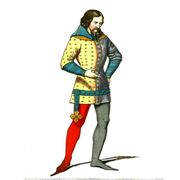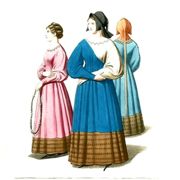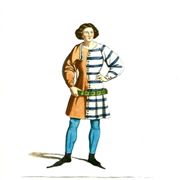Everyday Life in Renaissance
Learn about the Everyday life during the Renaissance including housing, schools, shopping, food, clothing, and entertainment.

Everyday Life in Renaissance
The common person’s everyday life changed as well as Europe underwent a transformation from the Middle Ages to the Renaissance. More luxuries, prettier attire, finer cuisine, and the arts became increasingly popular. The number of craftsmen, artisans, and merchants increased, and they formed a middle class of wealthy individuals who were not nobles or members of the aristocracy.



Medieval Clothing by Paul Mercuri
Of course, a lot of people continued to lead difficult, labor-intensive lives. The majority of a farmer’s and peasant’s day was spent at work, with few opportunities to advance in society.
Housing
Poor farmers typically lived in one-room huts, while wealthier merchants started to build larger dwellings. Compared to modern housing, these dwellings would have been gloomy and chilly. Both running water and bathrooms were absent. They most likely had a strong odor.
Food
The majority of people consumed bread and stew, whereas the wealthy consumed other interesting and upscale meals. Because the water made them queasy, they typically drank beer or wine with their meals. For more information on the cuisine of the Renaissance, see here.
Clothing
In the Renaissance, clothing had a significant role as a status symbol. Wealthy people dressed elegantly. Women wore long dresses, while men wore a doublet, a tight coat. For more information on Renaissance clothes, click here.
Religion
Christianity was the dominant religion in Renaissance Europe, and the Catholic Church was the dominant church. Yet, new concepts emerged at this time, such as the Humanist philosophy and the Protestantism, a new branch of Christianity. Due to its emphasis on human achievement and the study of nature, humanism was crucial to the Renaissance.
Entertainment
Throughout the Renaissance, people enjoyed a wide variety of entertainment. They participated in sporting activities, festivals, and games like backgammon, checkers, and chess. The largest occasion was probably carnival, which was held annually prior to Lent. For the Masquerade, people would have large gatherings and dress in costumes.
Shopping and Money
Shopping would take place in the local market. Smaller communities would have set market days when local shopkeepers and artisans would sell their wares. Money regulation wasn’t as strict as it is now. Every major city had its own currency, and the coin values might fluctuate often.
Children During the Renaissance
The way children were handled underwent significant shift during the Renaissance. At the beginning of the Renaissance, young adults were treated like children. They had to behave, speak, and dress like grownups. They were to get down to work as soon as they could. In general, they weren’t cuddled or hugged.
But during the Renaissance, individuals started treating their kids differently since they had more spare time and money. Children from wealthy families occasionally received loving care and had free time to play and enjoy childhood.
School
Those with money went to school more often. A well-off child, particularly a boy, would either go to college or have a private tutor. They primarily studied grammar and math, but some also took classes in philosophy, Roman, and public speaking.
Facts about Everyday Life in Renaissance
- During the Italian Renaissance of the 15th and 16th centuries, the ballet dancing style was created.
- Large birds like swans, peacocks, and herons were among of the nobility’ favorite delicacies.
- Renaissance daily life included a significant amount of music and dancing as a popular form of amusement.
- Italian Andrea Amati created the first violin in the Renaissance around 1555.
- The printing press’s development and the proliferation of books throughout the Renaissance greatly affected people’s day-to-day existence.
Everyday Life in Renaissance
Read also : The Northern Renaissance History and Facts
 The First Encyclopedia Your First Knowledge Home
The First Encyclopedia Your First Knowledge Home
